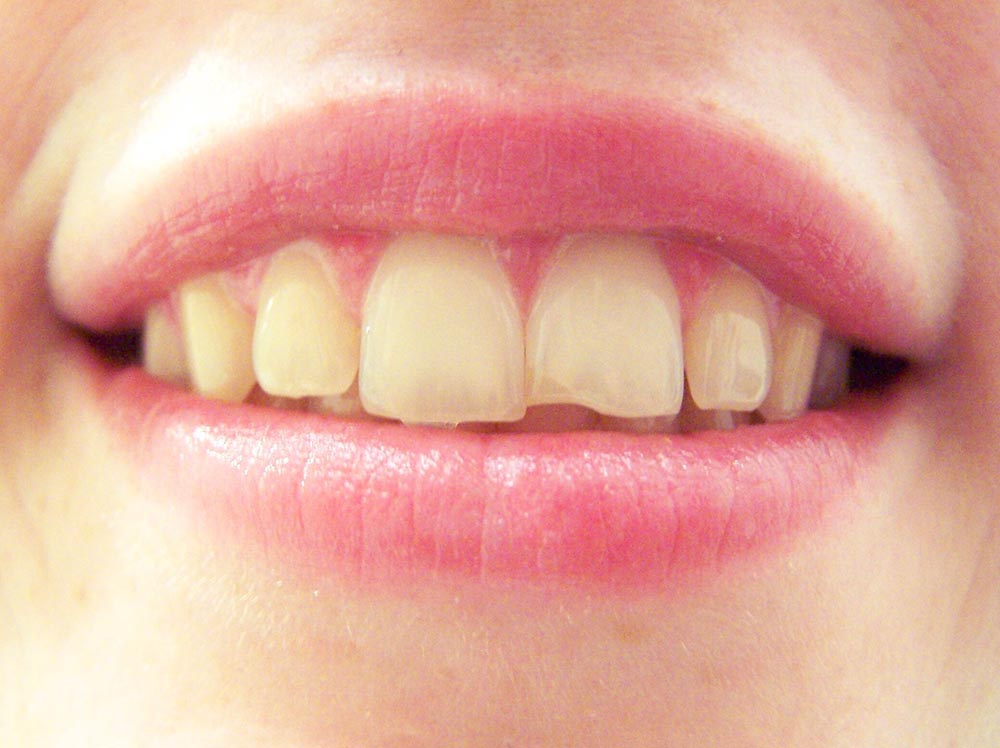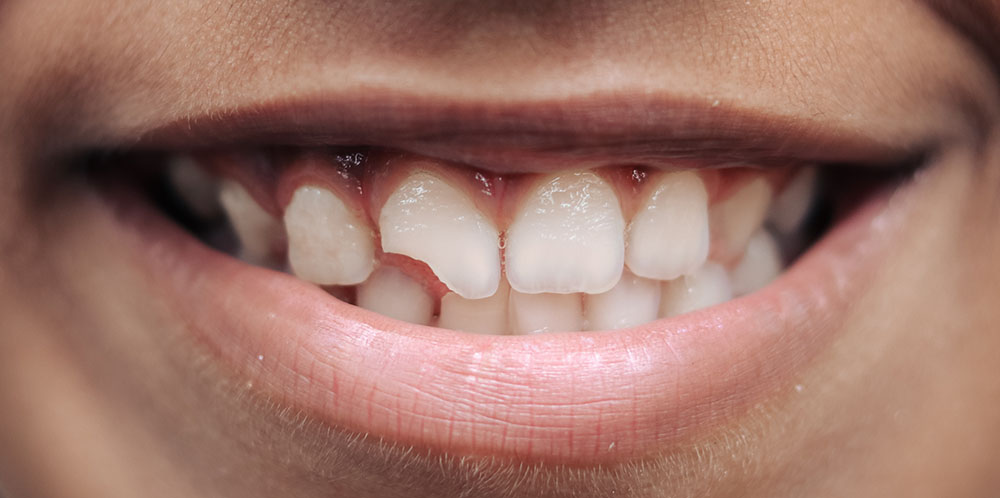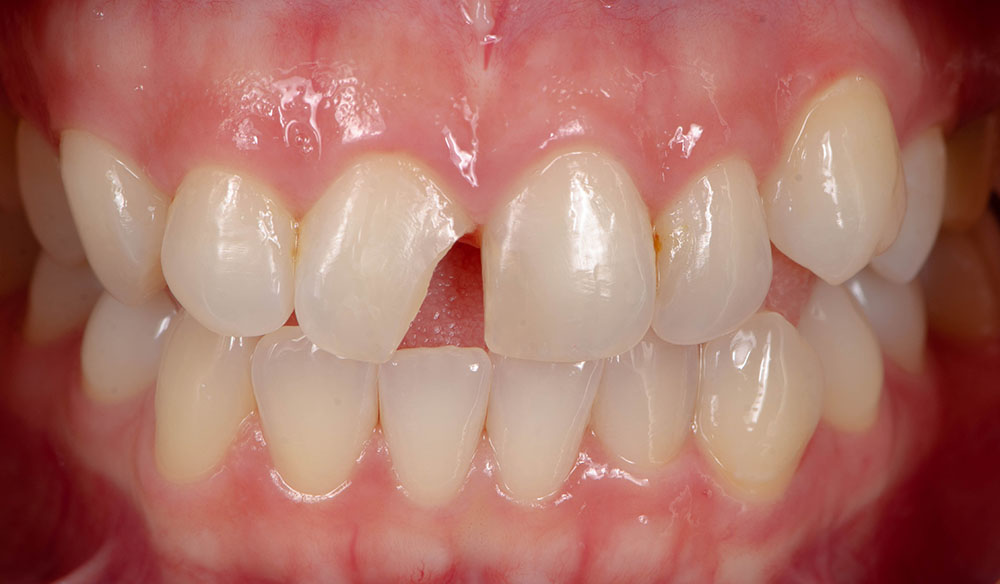Chipped Tooth: What to Do Next?

A chipped tooth is one of the most common dental injuries. Even if the mechanical damage to the tooth does not cause any pain, it is important to see a dentist without delay. Otherwise, a minor painless injury can lead to serious complications including losing the tooth.
Why do teeth chip? What symptoms indicate an injury? What types of chips are there? How is a chipped tooth restored? Find out in our article.
Causes of Tooth Chipping
A chipped tooth is a defect that is characterized by partial loss of tooth tissue due to mechanical impact. The most common reasons for chipped teeth are:
The main cause of chipped teeth. Usually occurs from falls, blows, or biting on hard foods.
Causes incorrect distribution of pressure on teeth. Regular increased loads on one or several teeth weaken the enamel layer.
Uncontrolled clenching of the jaw muscles and teeth grinding lead to increased enamel wear. Over time, cracks and chips form.
Plaque buildup on teeth, metabolic disorders, and aging lead to mineral loss in hard tissues. Enamel weakens, and the strength of teeth decreases.
Subgingival and interdental cavities can quietly destroy tooth tissue. The tooth may appear healthy but gradually weakens and becomes fragile.
Poorly treated root canals are at risk of recurrent inflammation. The crown may begin to deteriorate.
Some patients bite their nails, crack seeds, and open bottles with their teeth. Microcracks form on the teeth, which gradually increase.
Symptoms of a chipped tooth
In case of minor chips, symptoms of the defect may not be noticeable. A chip on a depulpated tooth may also go unnoticed. For medium and large chips, the following signs are typical:
Roughness of the tooth, formation of a sharp edge
Loss / destruction of the filling (if the enamel has chipped in the area of filling)
Hyper-sensitivity of the injured tooth to temperature and mechanical irritants
Severe pain and bleeding in the area of the damage
Small Chips
Only the enamel structure is damaged – a crack has formed in the tooth or a small piece of dental tissue has broken off. The dentin is not affected. In some cases, increased sensitivity to temperature stimuli may occur.
Usually, small chips are painless. However, it is not advisable to postpone a visit to the dentist, especially if the chip is in a front tooth, which can affect the aesthetics of the smile. In addition, even a small chip is susceptible to the effects of pathogenic bacteria. There is a risk of developing tooth decay and further destruction of the hard tooth tissues.

Medium Chips
An injury can cause both the enamel and dentin to damage. Pain occurs and the affected tooth is sensitive to temperature and mechanical irritants. Damage to the dentin may slightly expose the pulp, and microflora from the oral cavity can infect it. If the tooth is not treated promptly, it will continue to deteriorate. It is recommended to see a dentist as soon as possible.

Large Chips
A fracture of the crown down to the base can result from a mechanical injury or advanced decay. In large chips, the dentin and pulp are severely traumatized. Bacteria enter the exposed pulp chamber and quickly attack the tissues of the broken tooth, penetrating into the root canals. Often, trauma is accompanied by bleeding and severe throbbing pain, which is usually not relieved by analgesics. Emergency dental care is needed to save the tooth. If left unattended, the risk of having to remove the tooth increases.

What to Do If You Chipped a Tooth
If you can’t immediately visit a dentist, we recommend taking the following steps:
Gently rinse your mouth with warm (not hot) water or an antiseptic solution.This will help alleviate pain, remove blood, and irritants around the tooth
Do not touch the damaged tooth
Avoid cold, hot, acidic, hard, and sticky foods
Chew with your teeth on the opposite side of the defect
If the pain is unbearable, take pain relievers
If there is swelling in the area of the chip, apply a cold compress to the cheek for 10 minutes with breaks every half an hour for the first 2-3 hours
If there is bleeding, apply a sterile bandage
If the chip is small, immerse the broken piece of the tooth in saline solution, milk, or contact lens solution. As a last resort, use your own saliva. Sometimes the dentist can reattach the chipped enamel to its place
As soon as a chip appears, assess the degree of trauma. If there is no pain, we recommend visiting a dentist at a convenient time. If the chip is deep, it is necessary to see a dentist as soon as possible.
Treatment Methods in Dentistry
The doctor selects the method of restoring the tooth depending on the degree of injury.
Mild enamel chips and cracks
Defects within the enamel layer can be corrected by the following methods:
Micro-cracks and small surface chips in the enamel are polished and then subjected to remineralization and fluoridation. The treated surface is then coated with a compound rich in minerals and nutrients to help restore and strengthen its protective properties.
The damaged surface is processed and weakened tissues are removed. A filling material is then applied layer by layer to the defective area to match the patient’s enamel color. The restored area is then ground and polished.
Veneers are available in porcelain, ceramic E-max, and zirconia. They are recommended for shallow enamel chips in the smile zone. However, veneers are not applied to premolars and molars that have been chipped.
The dentist attaches a thin plate to the vestibular (front) part of the tooth. Prior to this, the enamel is prepared so that the veneer on the tooth looks natural and aesthetic against the backdrop of the dental arch.
Chipped half-tooth
If the trauma has affected the pulp, but the tooth roots have survived, the dentist will suggest installing a crown.
After diagnosis and analysis of X-rays, the dentist prepares the tooth for crowning. They remove decay (if present), eliminate inflammation, and perform endodontic treatment. Then, the dentist grinds the preserved part of the tooth, creates a stump for the crown. If necessary, they reinforce the tooth with a dowel (made from impressions). They take impressions for making the crown, which they fix to the patient’s tooth upon completion.
Deep fracture with root damage
If the tooth cannot be saved, the doctor recommends its removal with subsequent placement of a crown on an implant. The doctor performs the extraction of the tooth and places a dental implant in its place. On the day of implantation or within 3-7 days, the titanium root is loaded with a temporary crown. The permanent prosthesis is placed after full osseointegration of the dental implant – after 3-6 months.
Complications of chipped teeth
Patients with chipped teeth who do not promptly seek dental care may experience various problems, including:
Development of caries, pulpitis, or periodontitis in the area of the trauma
Increased sensitivity to mechanical / thermal irritants
Trauma to the oral mucosa by the sharp edge of the chipped tooth, leading to subsequent inflammation
Formation of a cyst on the root of the tooth, which may lead to its removal
Prevention of chipped teeth
To reduce the risk of chipped teeth, the following can help:
Thoroughly maintaining oral hygiene
Visiting the dentist for preventive check-ups every 6 months
Professional dental cleaning at the clinic once a year
Timely treatment of cavities
Orthodontic treatment for abnormal bite
Adding foods with high calcium, fiber, and vitamin D3 content to the diet
For minor chips, only symptoms such as hypersensitivity may pass, but the chips themselves do not heal. They can only be eliminated in a dentist’s office.
Front teeth are most susceptible to chipping. Usually, these are small enamel chips that occur as a result of patients’ harmful habits, such as opening bottles with their teeth or chewing on seeds.
Small chips within the enamel that do not require immediate attention from a dentist should be cleaned carefully. This is an ideal place for pathogenic microflora and caries to develop. Quality oral hygiene can help reduce the risks of tooth decay.
Before visiting the dentist, eat soft foods such as yogurt, porridge, fruit or mashed potatoes. Avoid hot, cold, and hard foods as they can cause increased sensitivity and pain.
Yes, even small chips gradually lead to losing your tooth.

